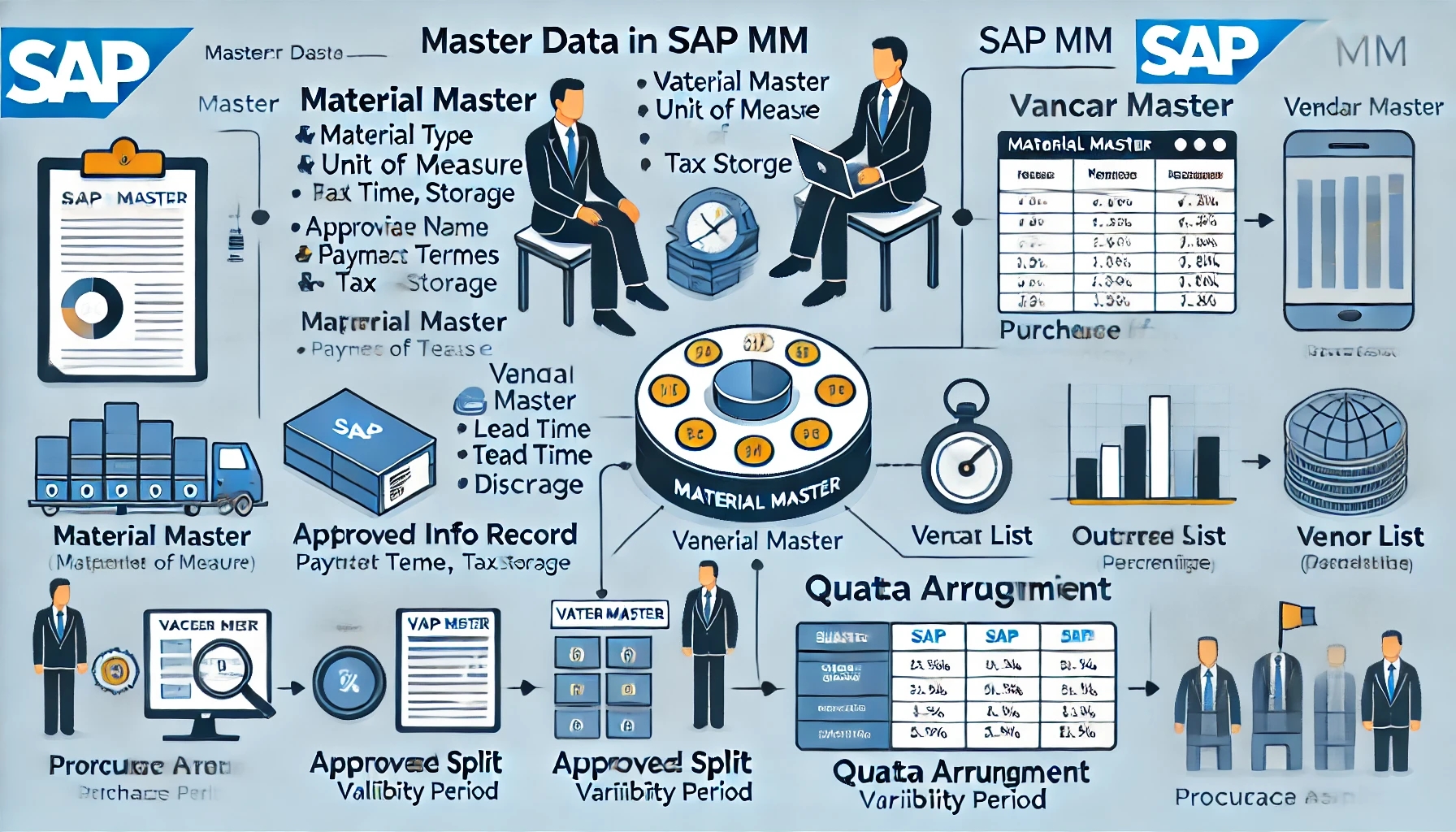Master Data Summary in SAP MM: In SAP MM (Materials Management), Master Data refers to the core data that remains constant over time and is used across various business processes. Master data serves as the foundation for all procurement, inventory management, and material valuation activities in SAP MM.
Master data is created once and used repeatedly across different transactions, ensuring consistency and reducing errors in the system.
Master Data Summary in SAP MM

Key Types of Master Data in SAP MM
Master data in SAP MM is broadly classified into five main categories:
| Master Data Type | Description | Example |
|---|---|---|
| Material Master | Central repository for all information related to a material (product). | Material type, unit of measure, price, storage location |
| Vendor Master | Information about suppliers who provide materials or services. | Vendor name, payment terms, tax information |
| Purchase Info Record (PIR) | Link between a material and a vendor, containing pricing and delivery terms. | Vendor-specific pricing, lead time, discounts |
| Source List | Defines which vendors are approved for specific materials. | Approved vendor for raw material supply |
| Quota Arrangement | Specifies how procurement is divided among multiple vendors. | 60% from Vendor A, 40% from Vendor B |
1. Material Master
The Material Master contains detailed information about materials used in the business.
It includes data like:
- Material Type (Raw Material, Finished Product, etc.)
- Unit of Measure
- Storage Location
- Price and Valuation
- Procurement Type (Internal or External)
- MRP (Material Requirement Planning) Details
Transaction Codes:
- Create Material Master →
MM01 - Change Material Master →
MM02 - Display Material Master →
MM03
2. Vendor Master
The Vendor Master contains all the data related to suppliers who provide materials or services.
It includes:
- Vendor Code
- Name and Address
- Payment Terms
- Tax Information
- Contact Information
Transaction Codes:
- Create Vendor →
XK01 - Change Vendor →
XK02 - Display Vendor →
XK03
Also Read: Purchase Information Record (PIR) and Text in SAP MM
3. Purchase Info Record (PIR)
A Purchase Information Record (PIR) establishes the relationship between a material and a vendor, containing
- Vendor-specific Pricing
- Delivery Terms
- Discounts and Surcharges
- Lead Time
Transaction Codes:
- Create PIR →
ME11 - Change PIR →
ME12 - Display PIR →
ME13
4. Source List
The Source List defines which vendors are allowed to supply a particular material.
It includes:
- Vendor Assignment
- Validity Period
- Fixed Vendor (if applicable)
- Blocked Vendors (if applicable)
Transaction Codes:
- Create Source List →
ME01 - Change Source List →
ME02 - Display Source List →
ME03
5. Quota Arrangement
The Quota Arrangement splits procurement of a material among different vendors.
It includes:
- Quota Percentage (e.g., 60% from Vendor A, 40% from Vendor B)
- Validity Period
- Procurement Type
Transaction Codes:
- Create Quota Arrangement →
MEQ1 - Change Quota Arrangement →
MEQ2 - Display Quota Arrangement →
MEQ3
Why Master Data is Important in SAP MM
✔️ Ensures consistency in data across the system.
✔️ Reduces manual entry errors.
✔️ Speeds up transaction processing.
✔️ Provides accurate reporting and analysis.
✔️ Facilitates automation in procurement and inventory processes.
Summary of Master Data in SAP MM
| Master Data | Purpose | Example |
|---|---|---|
| Material Master | Stores details about materials | Material Type, Price, Storage Location |
| Vendor Master | Stores details about suppliers | Vendor Name, Payment Terms, Tax Code |
| Purchase Info Record | Links material and vendor with purchasing terms | Price, Lead Time, Discounts |
| Source List | Defines approved vendors for a material | Vendor A approved from Jan 1 to Dec 31 |
| Quota Arrangement | Divides procurement among multiple vendors | 60% from Vendor A, 40% from Vendor B |